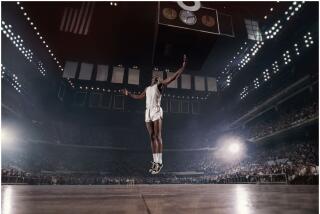Looking Back -- and Ahead
- Share via
We’ve long known the power of pictures -- cave drawings, paintings, photographs -- to portage a moment in time safely and silently to the eyes and imaginations of future viewers. The messages within Renaissance oils, Civil War photos, even Oregon Trail graffiti ignite wonder about history. What did George Washington really look like and Abraham Lincoln really sound like? How would history differ if, say, security pictures had revealed the nervousness of President McKinley’s approaching assassin and as a result left Theodore Roosevelt in vice presidential obscurity?
The march of technology -- phonographs, movies, TV and tape recordings -- captured new species of moments, from police and bystander videos to cockpit chatter and mere snapshots of families, even pets. Each evokes emotions. Each elicits the omniscience of 20/20 hindsight. Unlike the innocent faces there, we know what has happened subsequently. It’s captivating -- and eerie.
Now comes another 9/11 aural image, a tape recording newly released by New York authorities. We’ve already been touched by the calm and fearful farewells left on home answering machines by trapped World Trade Center workers. The new tape sounds mundane. It contains the professional radio exchanges of no-nonsense firefighters and police officers in the business of human rescues. They’re regular voices, with New Yawk accents, reporting to colleagues and superiors on locations, observations, equipment. They’re on a certain floor. They see this, hear that. Then, we realize one of the speakers is out of breath. Of course he is after climbing two-score floors in smoke, dust and noise against a fleeing tide of humanity.
That’s when the clarity of hindsight kicks in. We know today what they didn’t then. That soon after they were spoken, these conscientious, innocent, even naive words became outrageously outdated. The import of such simple reports would be magnified many times as the people who spoke them plummeted into posthumous fame as heroes. Even the most routine “10-4” is coated by our painfully detailed knowledge of the scale of what was happening in that place to these people who didn’t know. Can we feel guilty for watching then and listening now?
Like all post-disaster forensics, the tapes offer useful lessons for vastly improved emergency strategies, building methods and crisis communications. The surviving witnesses -- and they are basically all of us still here today going about the daily routine as if our tomorrows are innumerable -- may be pierced by the pathos of hindsight. Looking back does that at first. But at some point in time, that awful hollow ache of hindsight can become the fortifying wisdom of foresight. Perhaps the unspoken message today of these simple words from last year is: That point in time is now.
More to Read
The biggest entertainment stories
Get our big stories about Hollywood, film, television, music, arts, culture and more right in your inbox as soon as they publish.
You may occasionally receive promotional content from the Los Angeles Times.










